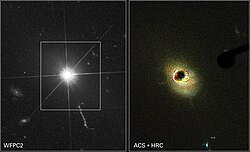3C 273
| Galaxie 3C 273 | |
|---|---|
(c) ESA/Hubble, CC BY 4.0 | |
| Aufnahme des Hubble-Weltraumteleskops | |
| AladinLite | |
| Sternbild | Jungfrau |
| Position Äquinoktium: J2000.0, Epoche: J2000.0 | |
| Rektaszension | 12h 29m 06,7s[1] |
| Deklination | +02° 03′ 09″[1] |
| Erscheinungsbild | |
| Morphologischer Typ | blazar;Sy1;LPQ FSRQ |
| Helligkeit (visuell) | 12,86 mag |
| Physikalische Daten | |
| Rotverschiebung | 0.158339 ±0.000067[1] |
| Radialgeschwindigkeit | 47469 ±20 km/s[1] |
| Hubbledistanz H0 = 73 km/(s • Mpc) | (2117 ± 148) · 106 Lj (649,1 ± 45,4) Mpc [1] |
| Geschichte | |
| Katalogbezeichnungen | |
| PGC 41121 • 2MASX J12290674+0203083 • HIP 60936 | |
3C 273 ist die Bezeichnung des scheinbar hellsten Quasars am Sternenhimmel. 3C 273 war der erste entdeckte Quasar. Das Objekt befindet sich im Sternbild Jungfrau, steht in der Nähe der Ekliptik und kann gelegentlich vom Mond bedeckt werden. Seine Rotverschiebung beträgt z = 0,158, womit sich seine Leuchtkraftentfernung im ΛCDM-Modell zu 746,9 Mpc bzw. 2,436 Milliarden Lichtjahren ergibt. Über Reverberation-Mapping ließ sich die Masse zu 886 ± 187 Millionen Sonnenmassen bestimmen.
Entdeckung
Maarten Schmidt entdeckte 1963 bei der näheren Untersuchung der zuvor von Martin Ryle kartographierten kosmischen Radioquellen, dass 3C 273 aus Ryles Third Cambridge Catalogue („3C“) eine sehr hohe Rotverschiebung aufwies, die nicht zu seinem Anschein als punktförmig erscheinender Einzelstern passte. Die Radiogalaxie 3C 273 war daher, wie sich herausstellte, nur „quasi stellar“, was zum Namen „Quasar“ führte.
Helligkeit und Beobachtung
3C 273 besitzt eine scheinbare Helligkeit von +12,86 mag sowie eine absolute Helligkeit von −26,7 mag. Damit ist der Quasar 300 mal heller als die Milchstraße und 4,1 Billionen mal heller als die Sonne.
In einer klaren Nacht ist 3C 273 als leuchtendes Pünktchen im Okular eines guten Amateurteleskops zu erkennen. Das Objekt befindet sich etwa 4° in ost-ost-südlicher „8 Uhr“-Richtung von 16 Vir (5 mag). Aufgrund der geringen scheinbaren Helligkeit ist der Quasar aber nur mit einer sehr guten Sternkarte sicher zu finden. Für eine grobe Orientierung kann die Sternkarte unten herangezogen werden.
3C 273: Sternkarte
3C 273, aufgenommen mit einer ToUcam an einem 10″ SCT mit 600 mm Brennweite
Die umgebende Galaxie wird in einer Aufnahme mit einem Koronograf des Hubble-Weltraumteleskops erkennbar.
Weblinks
- Parkes and 3C273 – The Identification of the First Quasar CSIRO Parkes Observatory (englisch)
- Datenblatt von 3C 273 beim INTEGRAL Science Data Centre (ESA)
- Best image of bright quasar 3C 273 (engl.)
- Aufnahmen von 3C 273
Einzelnachweise
Auf dieser Seite verwendete Medien
Aufnahme von Quasar 3C273 mit der ToUcam vom 20.4.2006 an einem 10" SCT mit 600mm Brennweite. Der Quasar ist der hellste "Stern" einer Sternendreiergruppe knapp links-unterhalb "8 Uhr" der Bildmitte. Das Bildfeld umfasst 20,5 × 15,5 Bogenminuten, ein Pixel entspricht somit knapp 2 Bogensekunden. "Natürliche" Ausrichtung: Norden ist oben, Osten links.
Aufsuchkarte für Quasar 3C273. Die rote Linie markiert die Ekliptik, darüber ist der westliche Teil des Sternbilds Jungfrau zu sehen. "Natürliche" Ausrichtung: Norden ist oben, Osten links. Autor: Klaus Hohmann
http://astrofotografie.ilo.de/Hubble Probes the Heart of a Nearby Quasar.
(c) ESA/Hubble, CC BY 4.0
This image from Hubble’s Wide Field and Planetary Camera 2 (WFPC2) is likely the best of ancient and brilliant quasar 3C 273, which resides in a giant elliptical galaxy in the constellation of Virgo (The Virgin). Its light has taken some 2.5 billion years to reach us. Despite this great distance, it is still one of the closest quasars to our home. It was the first quasar ever to be identified, and was discovered in the early 1960s by astronomer Allan Sandage.
The term quasar is an abbreviation of the phrase “quasi-stellar radio source”, as they appear to be star-like on the sky. In fact, quasars are the intensely powerful centres of distant, active galaxies, powered by a huge disc of particles surrounding a supermassive black hole. As material from this disc falls inwards, some quasars — including 3C 273 — have been observed to fire off super-fast jets into the surrounding space. In this picture, one of these jets appears as a cloudy streak, measuring some 200 000 light-years in length.
Quasars are capable of emitting hundreds or even thousands of times the entire energy output of our galaxy, making them some of the most luminous and energetic objects in the entire Universe. Of these very bright objects, 3C 273 is the brightest in our skies. If it was located 30 light-years from our own planet — roughly seven times the distance between Earth and Proxima Centauri, the nearest star to us after the Sun — it would still appear as bright as the Sun in the sky.
WFPC2 was installed on Hubble during shuttle mission STS-125. It is the size of a small piano and was capable of seeing images in the visible, near-ultraviolet, and near-infrared parts of the spectrum.






